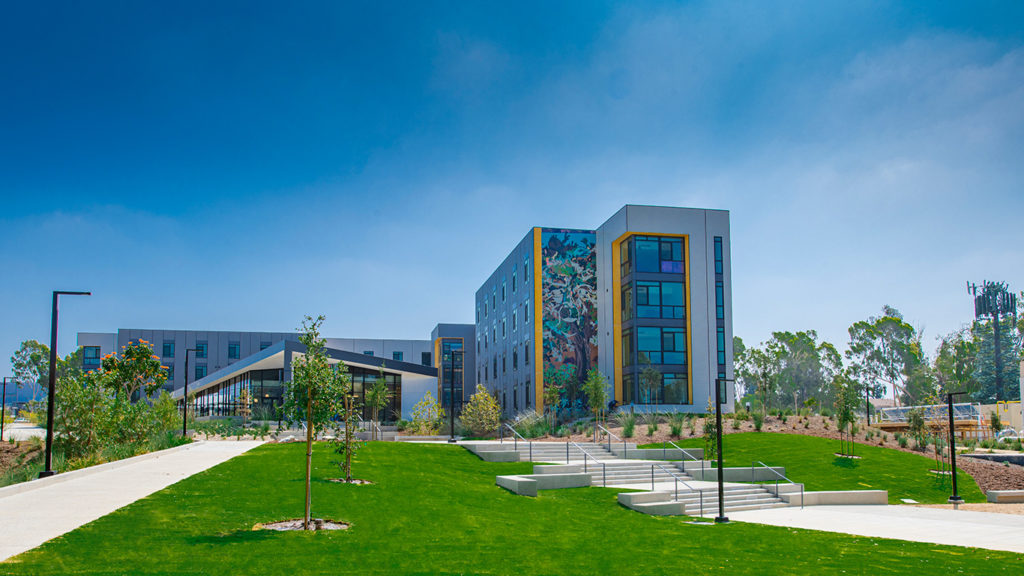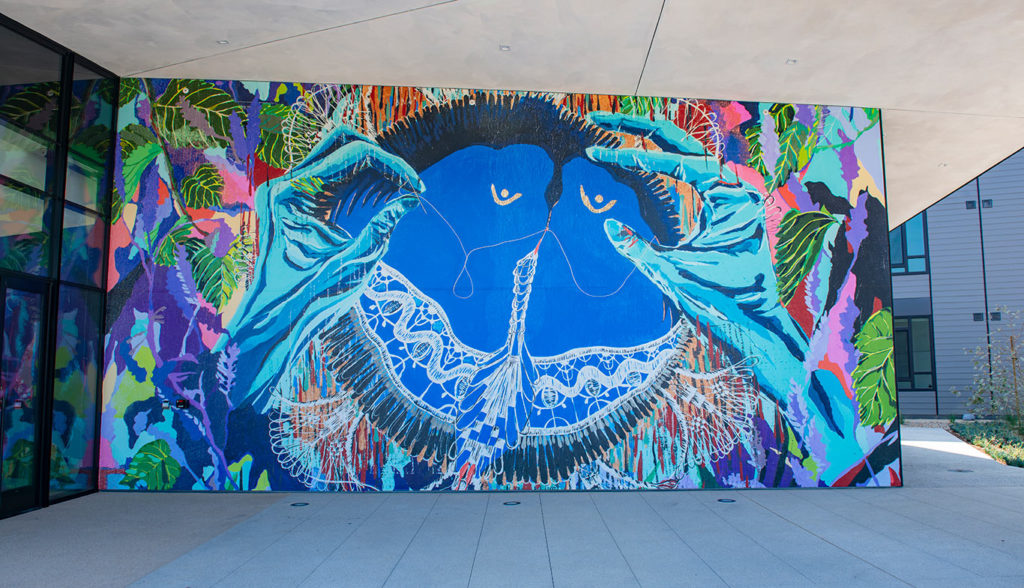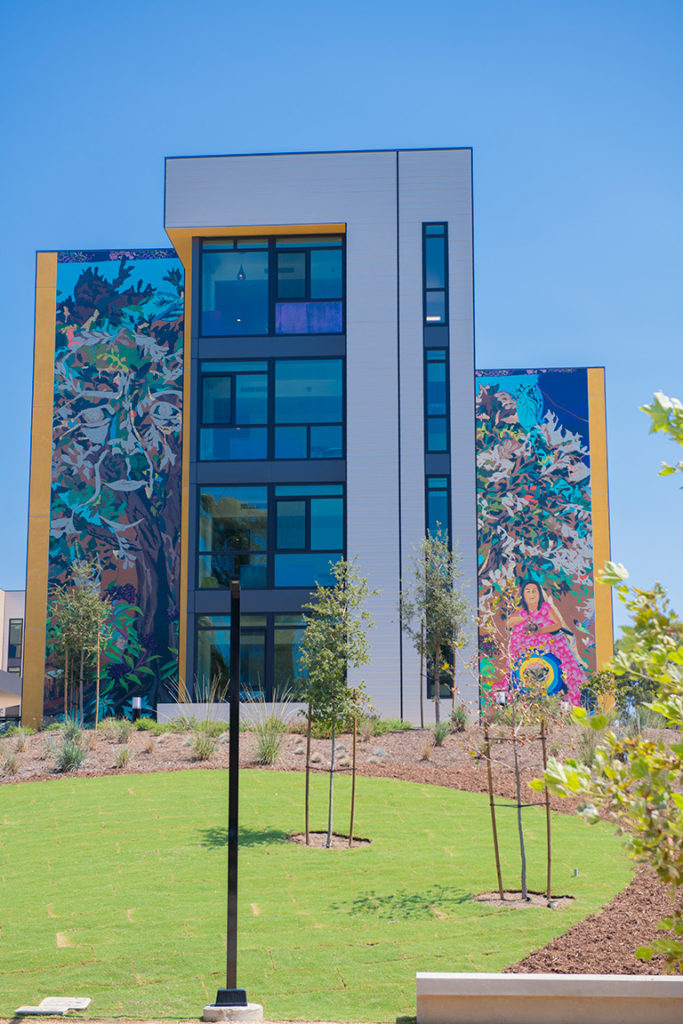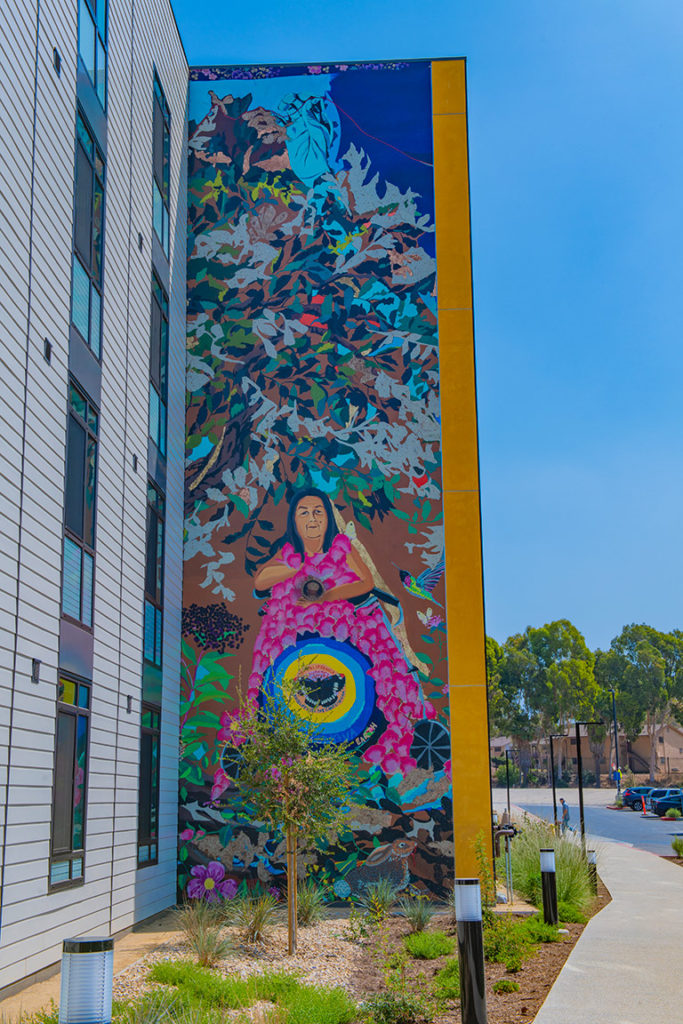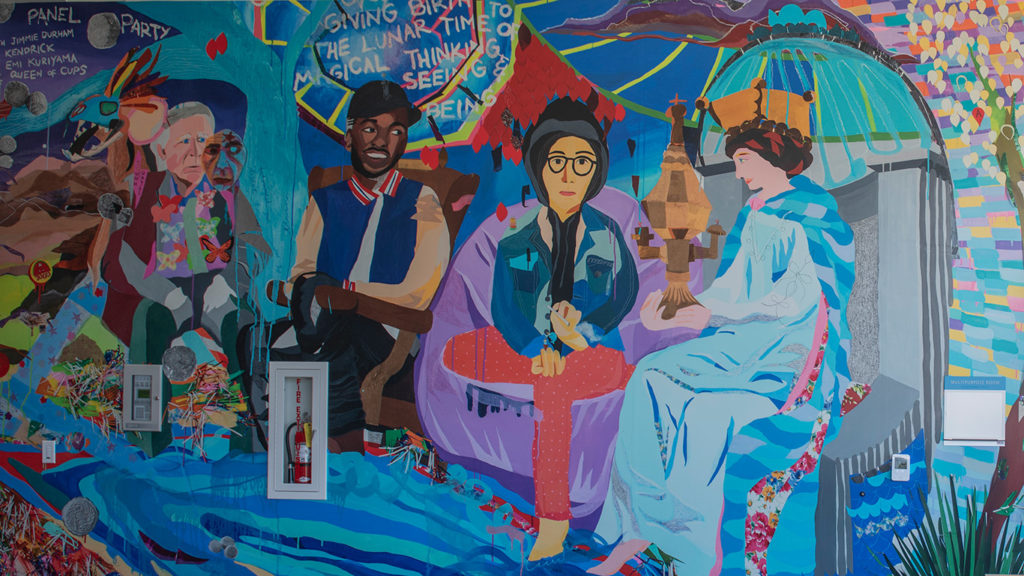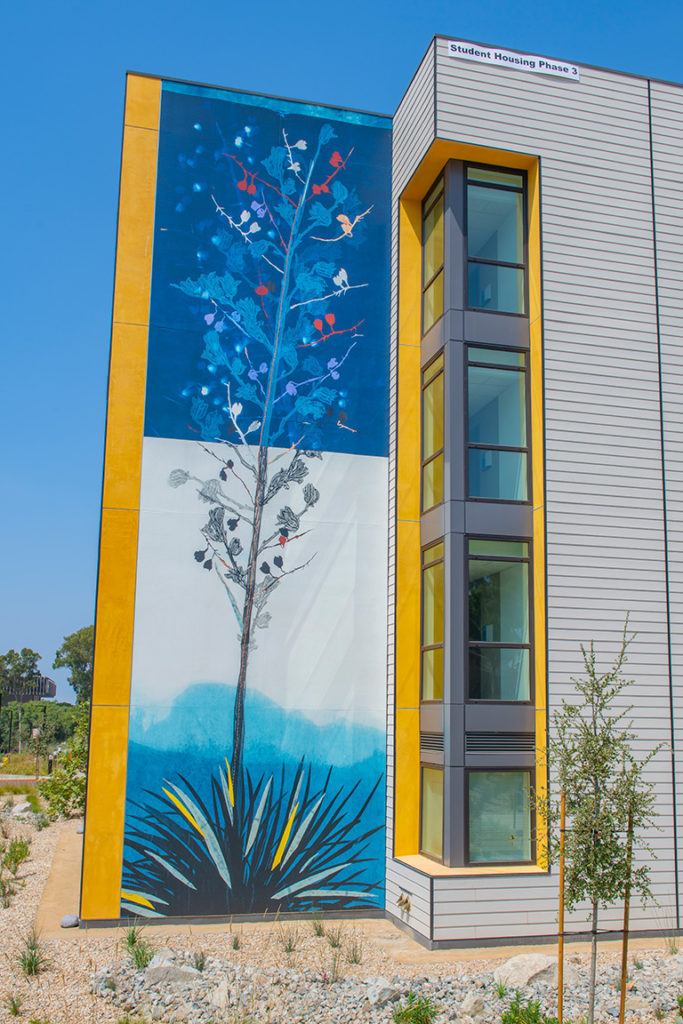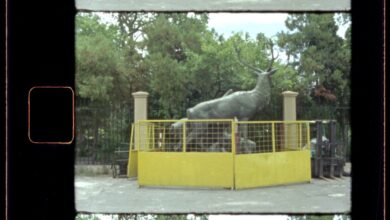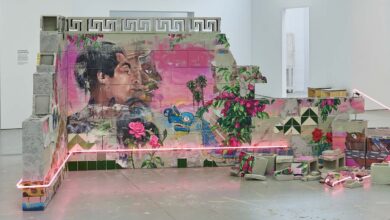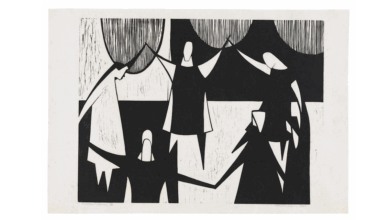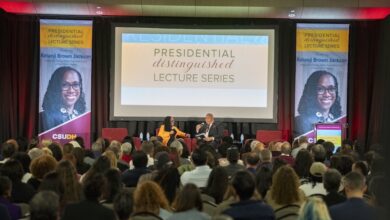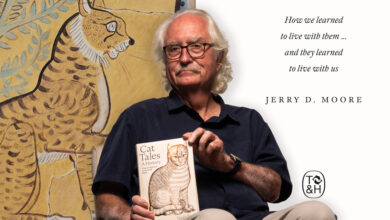 The art of Los Angeles painter iris yirei hu, which tells stories of people, places, and pain and often their interdependencies, now adorns California State University, Dominguez Hills’ (CSUDH) new Student Residence Hall in the form of eight 47-foot murals that were recently installed during the final phase of construction.
The art of Los Angeles painter iris yirei hu, which tells stories of people, places, and pain and often their interdependencies, now adorns California State University, Dominguez Hills’ (CSUDH) new Student Residence Hall in the form of eight 47-foot murals that were recently installed during the final phase of construction.
Hu’s work was chosen by students, faculty, and staff of the university out of approximately 60 Southern California artists who responded to a region-wide call for submissions of existing work that could translate to large-scale murals. The call represents CSUDH’s first major public art project on its campus in more than a decade.
The highly collaborative painter, weaver, and writer selected the pieces that would be displayed on the housing complex from a body of work that spans five years.
“I hope the murals will speak well to students, and it’s meaningful to me that they will get to live with the art,” she said. “For students, who are learning to heal, struggle, and experiment collaboratively, I think it’s significant to have images of people of color existing and working together decorating their place of residence, study, partying, life making.”
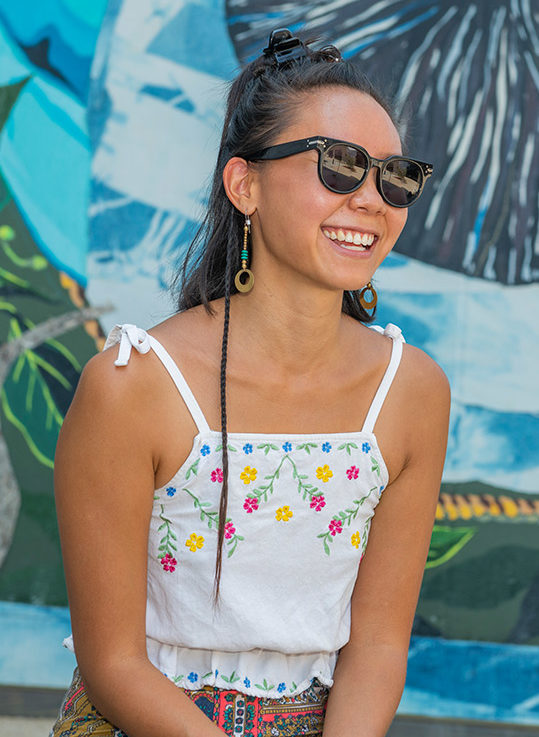
CSUDH’s new student housing complex’s exterior was designed to feature roof-to-ground art, providing what university officials considered the perfect canvas to highlight artists in the community. Reproducing murals onto high-quality vinyl will enable CSUDH to change the art every few years. The university’s newly formed Art Advisory Committee viewed the highly visible art project as having great transformative potential, particularly in accelerating the installation of other public art on campus.
“We had so many talented artists and impressive submissions to consider and iris yirei hu’s work still stood out to us as an exceptional fit for this project,” said Director of University Housing Lynn Arthur, who chaired the housing mural selection committee. “I was hoping for mural installations that would transform the aesthetic and purpose of this already beautiful new residence. This was my highest aspiration and hu’s magnificent pieces have certainly fulfilled that.”
Hu describes her own body of work as “heavily dependent on other people, their stories, and the landscapes from which they come.”
“I am interested in the stories that enable my story to be told, and I approach my life and art making by rendering our relations to one another,” hu said. “I am also interested in how disparate geographies, bodies, and temporalities are interconnected through trade, colonialism, and disenfranchisement, and how collaboration in the form of learning from, working with, and holding space for loss can enable transformative futures and friendships.”
The two towering murals that greet students at the main entrance of the student housing complex were taken from an installation hu did in collaboration with Elder Julia Bogany, a member of the Tongva tribe who serves on the tribal council and as their cultural consultant. She is prominently featured on one of the murals.
Indigenous to the Los Angeles basin, the Tongva were one group of many forced to labor in the Spanish missions of Los Angeles, San Gabriel, and San Fernando in the late 18th century.
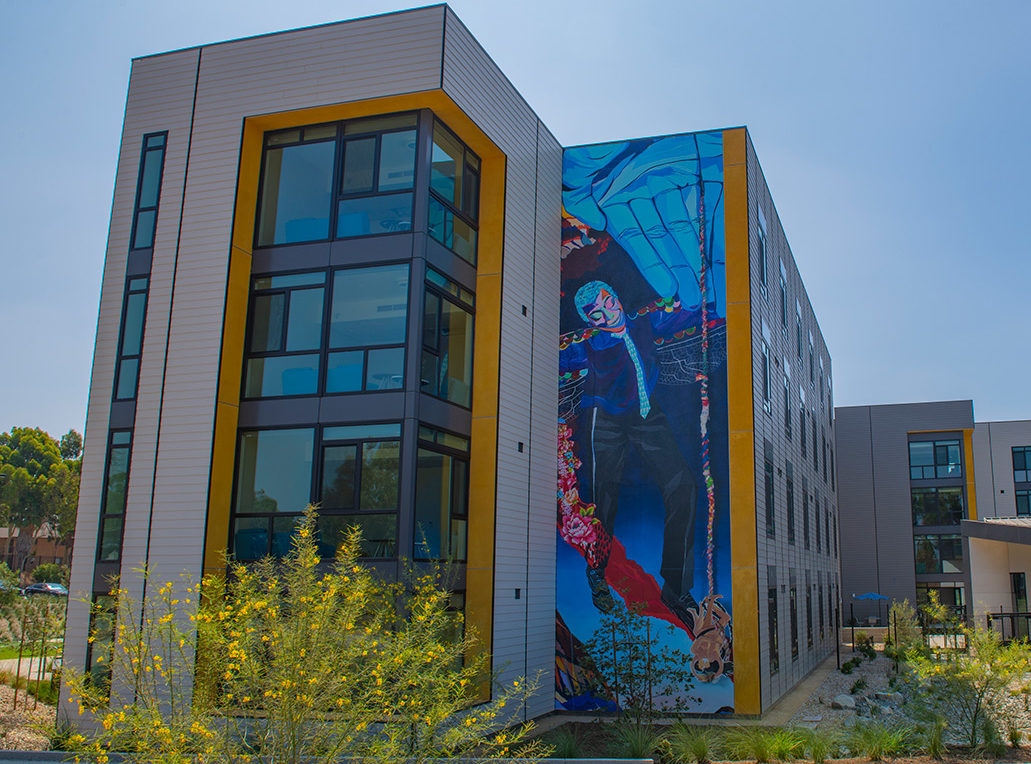
Hu grew up in San Gabriel, where the mission remains a central monument in the city. She says that Bogany’s great-grandmother “passed through” the mission, which made it important for hu to make a connection with Bogany and nurture their relationship.
“I was connected to Julia to revise my understanding of the history, presence, and futures of the Tongva people. But growing up, while my high school was named Gabrielino directly after the Spanish name for the Tongva, we didn’t have much education about the indigenous history of our neighborhood and the Greater Los Angeles area,” hu explained. “So I see having two murals of Elder Julia Bogany with her grandmother’s spirit personified in the oak tree as a reminder of who stewarded the land on which the university sits, and whose future to center.”
Hu says that over the last few decades there has been a significant effort to revitalize the identity of the tribe, with many Tongva youth becoming activists and artists. Guided by elders, they use art and other platforms to help revitalize their heritage.
“Many Tongva tribal members have dedicated their entire lives to reclaiming their history and making palpable knowledge that was lost during the mass incarceration of their people and the subsequent genocide during California’s claim to statehood and the hidden silence of assimilation,” she said.
One of the eight murals is influenced by African American writer and activist James Baldwin, who hu finds it important to have larger than life – “sort of part dragonfly and part ancestor.”
“Dragonflies are living fossils that have withstood and transformed through the ages of the earth. I painted James Baldwin dancing when I was in school, and studying his work made me want to create a mythical space where we could be in dialogue,” hu said. “On a campus that is majority students of color, I wanted to share that while our struggles and pains are different, we must remain very aligned and connected. It’s important to see Black leaders and intellectuals of color experience joy within the struggle that they inherited, because that joy is impenetrable, of a community, and transformative”
Arthur expects hu’s work will “intrigue and delight” the campus community.
“Like our university, Iris cares about collaborative relationships, social justice, equality, and sustainability,” Arthur said. “These are common themes in her work and so much of what is on display at the student residence hall has this magical way of portraying reality and fantasy simultaneously. I think our students will easily connect with those juxtapositions.”
